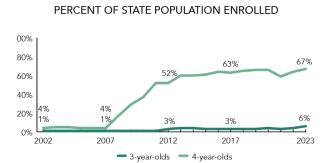
State of Preschool
Access Rankings
Resource Rankings
Total Benchmarks Met
Overview

During the 2022-2023 school year, Iowa preschool enrolled 28,194 children, an increase of 1,116 from the prior year. State spending totaled $94,650,334 and an additional $1,687,987 in federal recovery funds supported the program, down $3,246,970 (3%), adjusted for inflation, since last year. State spending per child (including federal recovery funds) equaled $3,705 in 2022-2023, up $27 from 2021-2022, adjusted for inflation. Iowa met 8 of 10 quality standards benchmarks.
What's New
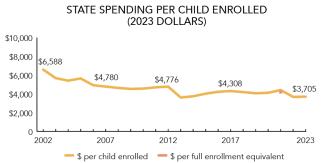
A new state commitment provides Shared Visions (SV) grantees with access to an online program, which supports early language development and family engagement, starting in the 2022-2023 program year. Eligibility guidelines for SV have been adjusted for more children to be eligible beginning in the 2023-2024 grant year.
Background
Iowa has two state-funded preschool programs: Shared Visions (SV) and the Statewide Voluntary Preschool Program (SWVPP). The SV program has provided services to 3-, 4-, and 5-year-olds since 1989 through competitive grants to public schools, licensed non-profit childcare centers, other public non-profit agencies, and Head Start. SV serves children in part-, school-, or extended-day programs.
Iowa began the SWVPP in 2007 to increase 4-year-olds’ access to preschool. All 4-year-olds in the state are eligible to attend SWVPP. Funding for the SWVPP is based on the state funding formula in which 4-year-olds are funded at 50% of the K–12 state aid amount. SWVPP classrooms operate at least 10 hours per week and programs may collaborate with Head Start, other preschool programs, or childcare programs to provide the SWVPP. Some collaborations offer full-day services.
Both SWVPP and SV have undergone formal evaluations. As part of the state longitudinal data system, all children enrolled in either program receive a unique state identification number.
An important difference between the two state-funded preschool programs pertains to child eligibility. SV is a targeted program where at least 80% of children are required to meet income eligibility guidelines (family income at or below 130% FPL). Children can also qualify for the program based on other risk factors but may be required to pay a fee based on a sliding scale. Services within this program are provided in 29 of Iowa’s 99 counties through 49 awarded grants. Programming is offered in 23 school district locations (through 16 school districts), representing less than 5% of school districts. In addition, services are provided in 26 other community- based locations, representing 11 organizations. In contrast, SWVPP, is available in 99% of school districts and all resident children who turn four by September 15 are eligible to attend.
SV lead teachers are required to meet the educational qualifications as outlined in the program standards selected within the awarded application. While requirements within selected program standards vary, 73% of lead teachers hold a BA degree or higher in early childhood, child development, or a related field, while another 19% hold an AA degree in early childhood or a related field. All SWVPP lead teachers must have at least a BA and an Iowa teaching license with an early childhood endorsement.
Iowa’s overall support for state-funded preschool, including enrollment and funding for SV and SWVPP, is depicted in the first two pages of this state profile. The third page focuses on SV and the fourth page provides information on SWVPP.
-
Access
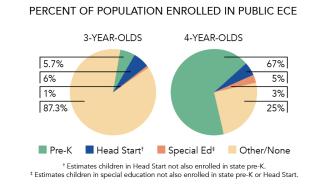
Total state pre-K enrollment 28,194 Special education enrollment, ages 3 and 4 4,348 Federally funded Head Start enrollment, ages 3 and 4 5,293 State-funded Head Start enrollment, ages 3 and 4 0 Resources
Total state pre-K spending $96,338,321 State Head Start spending $0 State spending per child enrolled $3,705 All reported spending per child enrolled* $3,831 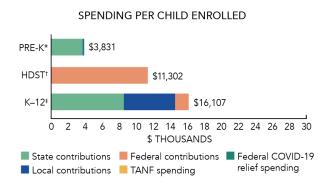
*Pre-K programs may receive additional funds from federal or local sources that are not included in this figure. †Head Start per-child spending includes funding only for 3- and 4-year-olds. ‡K–12 expenditures include capital spending as well as current operating expenditures.
-
Access
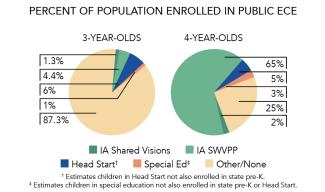
Total state pre-K enrollment 1,106 School districts that offer state program 29% (counties) Income requirement 130% FPL Minimum hours of operation Determined locally Operating schedule Determined locally Resources
Total state pre-K spending $6,391,823 Local match required? Yes State spending per child enrolled $5,779 All reported spending per child enrolled* $8,745 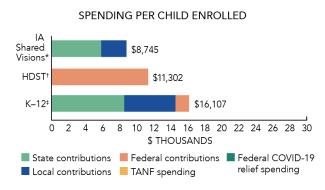
*Pre-K programs may receive additional funds from federal or local sources that are not included in this figure. †Head Start per-child spending includes funding only for 3- and 4-year-olds. ‡K–12 expenditures include capital spending as well as current operating expenditures.
Iowa Shared Visions Quality Standards Checklist
| Policy | IA Shared Visions Requirement | Benchmark | Meets Benchmark? |
|---|---|---|---|
For more information about the benchmarks, see the Executive Summary and the Roadmap to State pages. | 7benchmarks met | ||
| Early Learning & Development Standards Benchmark | Comprehensive, aligned, supported, culturally sensitive | Comprehensive, aligned, supported, culturally sensitive | |
| Curriculum Supports Benchmark | Approval process & supports | Approval process & supports | |
| Teacher Degree Benchmark | BA (public); AA (nonpublic) | BA | |
| Teacher Specialized Training Benchmark | ECE, CD | Specializing in pre-K | |
| Assistant Teacher Degree Benchmark | CDA or equivalent | CDA or equivalent | |
| Staff Professional Development Benchmark | PD hours based on program standards; PD plans; Coaching (teachers with an active teaching license only) | For teachers & assistants: At least 15 hours/year; individual PD plans; coaching | |
| Maximum Class Size Benchmark | 20 (3- & 4-year-olds) | 20 or lower | |
| Staff to Child Ratio Benchmark | 1:8 (3- & 4-year-olds) | 1:10 or better | |
| Screening & Referral Benchmark | Vision, hearing, health & more | Vision, hearing & health screenings; & referral | |
| Continuous Quality Improvement System Benchmark | Structured classroom observations (every 5 years and determined locally); Data used for program improvement | Structured classroom observations; data used for program improvement | |
-
Access

Total state pre-K enrollment 27,088 School districts that offer state program 99% Income requirement No income requirement Minimum hours of operation 10 hours/week Operating schedule Determined locally Resources
Total state pre-K spending $89,946,498 Local match required? No State spending per child enrolled $3,613 All reported spending per child enrolled* $3,613 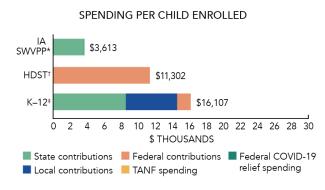
*Pre-K programs may receive additional funds from federal or local sources that are not included in this figure. †Head Start per-child spending includes funding only for 3- and 4-year-olds. ‡K–12 expenditures include capital spending as well as current operating expenditures.
Iowa Statewide Voluntary Preschool Program Quality Standards Checklist
| Policy | IA SWVPP Requirement | Benchmark | Meets Benchmark? |
|---|---|---|---|
For more information about the benchmarks, see the Executive Summary and the Roadmap to State pages. | 8benchmarks met | ||
| Early Learning & Development Standards Benchmark | Comprehensive, aligned, supported, culturally sensitive | Comprehensive, aligned, supported, culturally sensitive | |
| Curriculum Supports Benchmark | Approval process & supports | Approval process & supports | |
| Teacher Degree Benchmark | BA | BA | |
| Teacher Specialized Training Benchmark | ECE, CD, Elem Ed (with ECE endorsement) | Specializing in pre-K | |
| Assistant Teacher Degree Benchmark | CDA or equivalent | CDA or equivalent | |
| Staff Professional Development Benchmark | 15 hours/year recommended (teachers only); PD plans; Coaching (public only) | For teachers & assistants: At least 15 hours/year; individual PD plans; coaching | |
| Maximum Class Size Benchmark | 20 (3- & 4-year-olds) | 20 or lower | |
| Staff to Child Ratio Benchmark | 1:10 (3- & 4-year-olds) | 1:10 or better | |
| Screening & Referral Benchmark | Vision, hearing, health & more | Vision, hearing & health screenings; & referral | |
| Continuous Quality Improvement System Benchmark | Structured classroom observations; Data used for program improvement at the local level only | Structured classroom observations; data used for program improvement | |